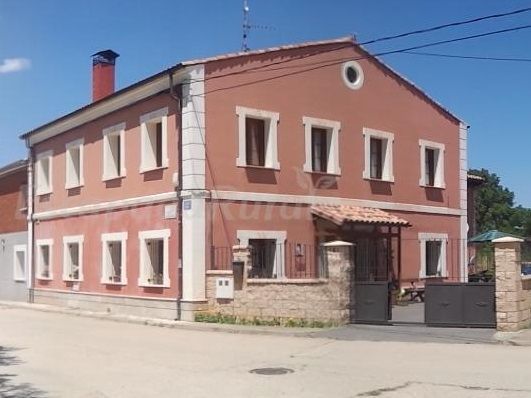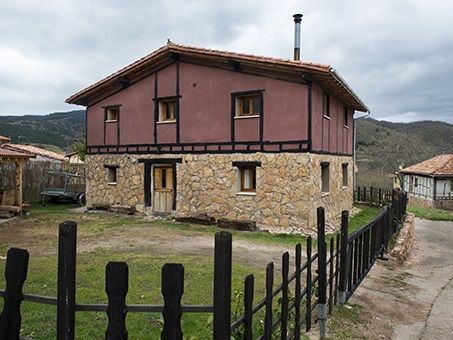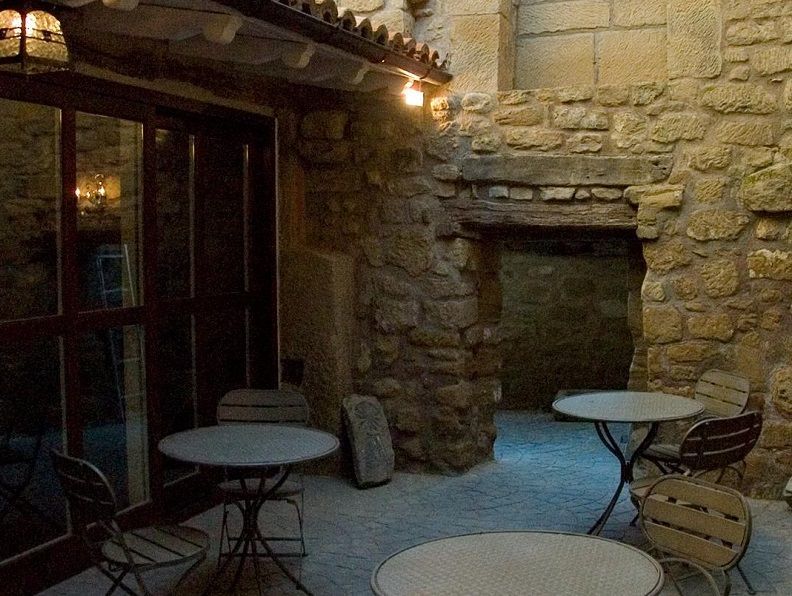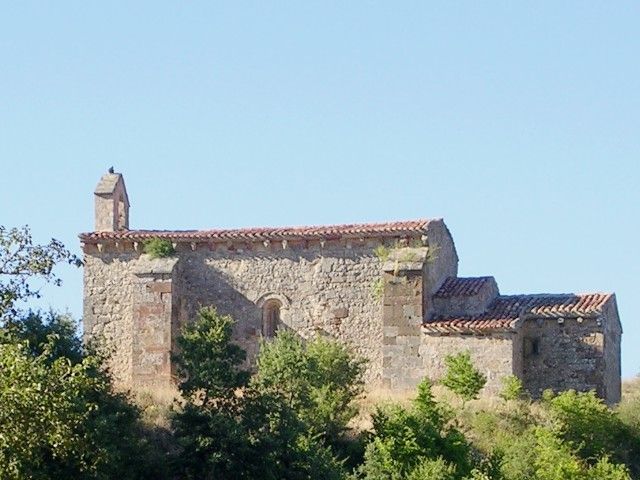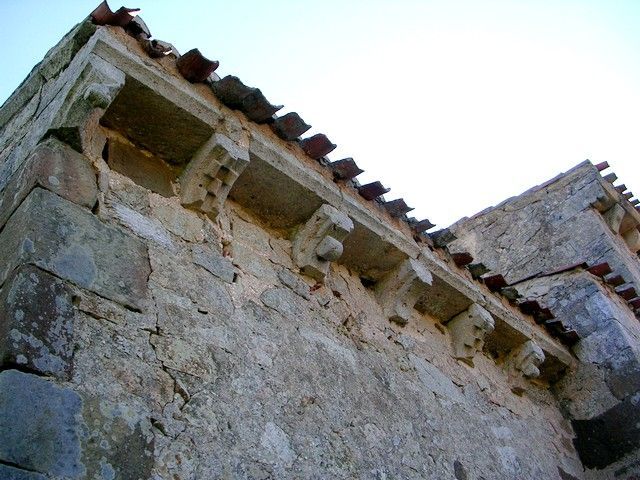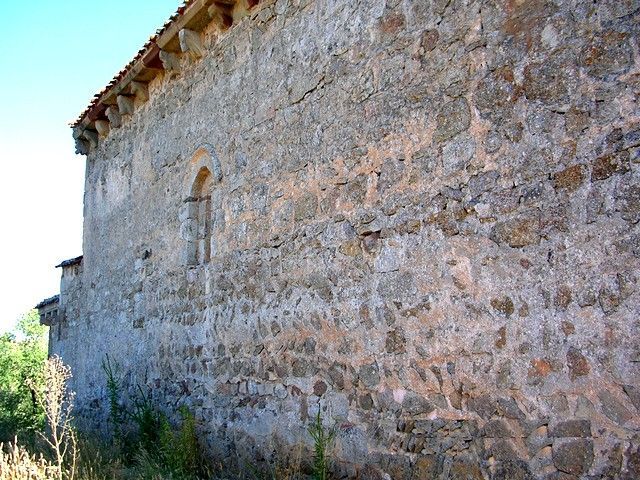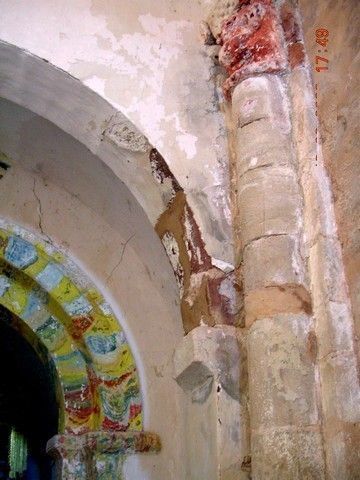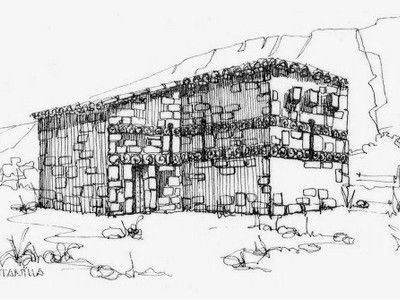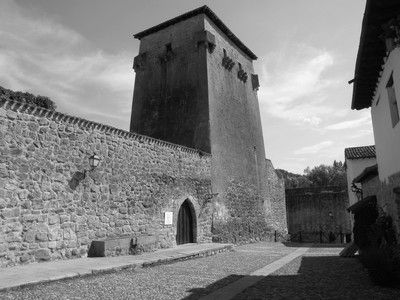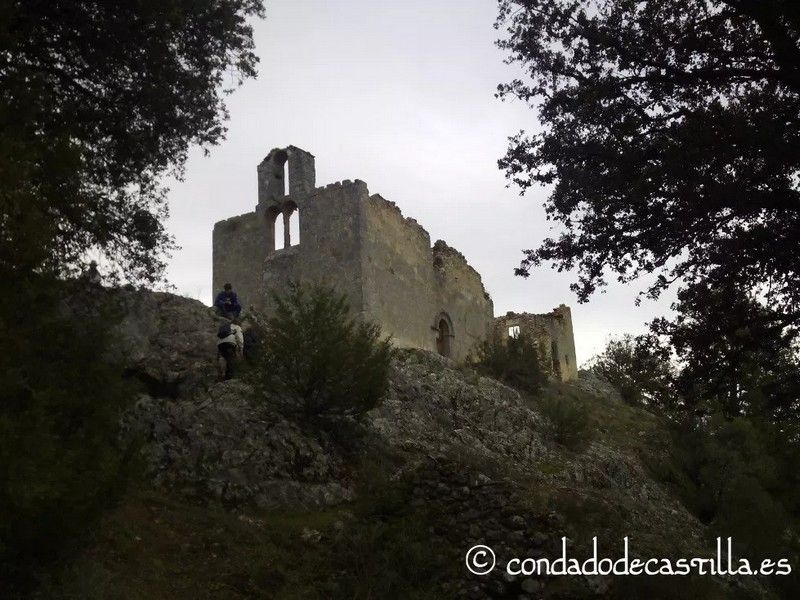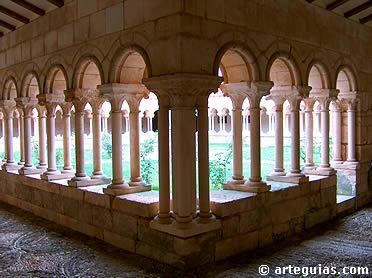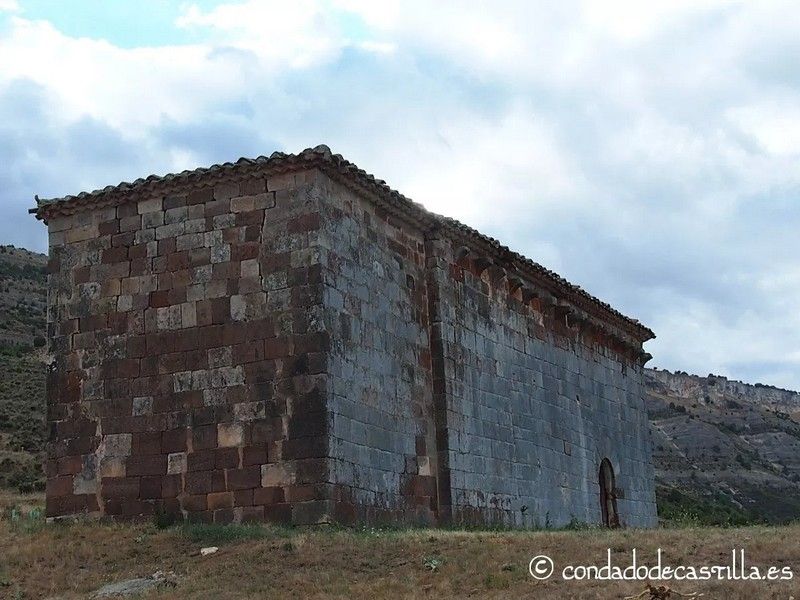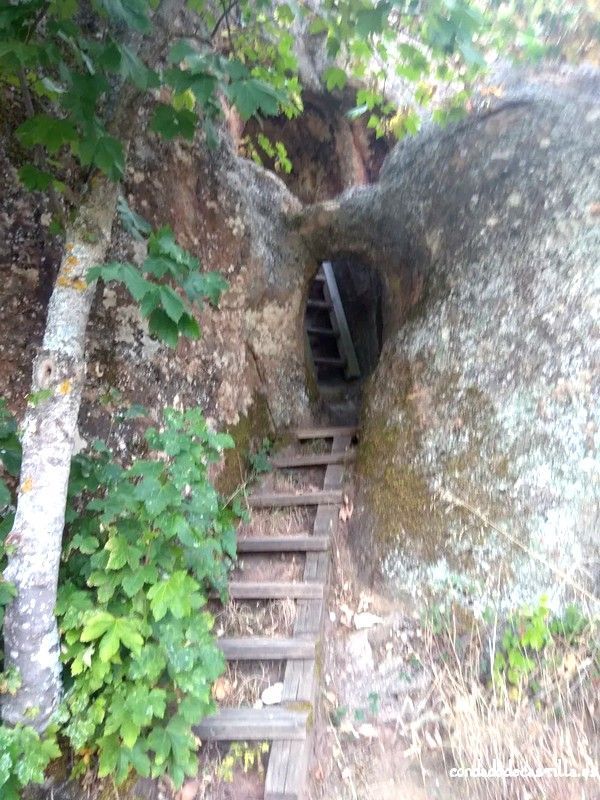ERMITA DE LA VIRGEN DEL CERRO
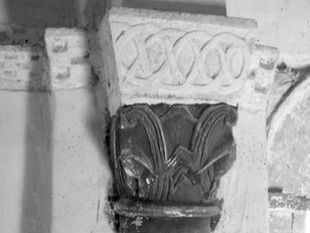
Thanks:
A nuestro amigo Juan Antonio Alonso, “burgalés de pro” y amante del Arte, que
nos ha dado a conocer este edificio de origen prerrománico y nos ha
proporcionado la información y las fotografías que se utilizan es esta ficha.
Previous notes
- Pequeña iglesia, formada por un ábside de testero plano y una nave
rectangular, estructura habitual en la repoblación del este de Castilla. - Aunque parte de su decoración anuncia ya el románico, muchas de sus
características rebelan una gran influencia de la arquitectura asturiana. - Por todo ello, resultaría muy interesante un estudio a fondo de este
edificio y su entorno.
Description
Upon a small hill located very near Cueva de Jarros, at around 20 Km from Burgos, we find this small church of 19.5m long by 6m wide, that at first sight would be unnoticed among the large ensemble of Romanesque buildings that have been preserved in the environnment, a great number of them much larger and with better artistic qualities. However, already at a first sight from far off we find an unusual detail, something that makes it different from the usual image of the Romanesque religious buildings: the fact that its only apse, conventionally placed towards east finishes in a flat chevet, what makes us think on a more ancient origin, that incites us to halt in order to study this monument more deeply.
Our suspicions are confirmed upon our approach. We find ourselves with a structure formed by a single very high nave and a chevet that consists of two sections of different heights, but both much lower than the nave. The first one is a small presbytery of equal width as the nave and the second one, an apse of rectangular shape, significantly narrower.
Later, during alterations in the 18th century, two big buttresses and a small vestry were added, all of that on its southern side. But, even ou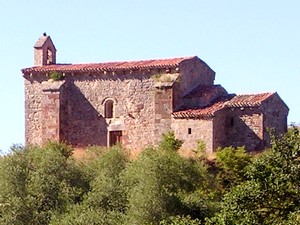 tside, we find several details that confirm the possibility that we are dealing with a much older construction, at least in its origin, previous to the early Romanesque.
tside, we find several details that confirm the possibility that we are dealing with a much older construction, at least in its origin, previous to the early Romanesque.
In fact, the first thing that calls our attention is that both, the present entrance through the southern side, as well as a walled-in door on the western wall have a lintel shape with a semi circular discharge arch in the purest Asturian style. Also at the western side and higher, the three blocked off spaces that end in a semicircular arch have been preserved and it seems that less than a century ago they were communicated with a part of the building called the “House of the Hermit”, that, according to its characteristics it seems it initially was a triple portico of a total height somewhat shorter than the nave and that it consisted of two stories although with staggered laterals with regard to the central one, an element that was also usual in Asturian art.
Another evident detail at a first sight is that the building style changes according to the height, although not homogeneously, between the different walls of the church, presenting in some areas of the lower parts a structure formed by slabs placed in spike shape, something quite usual among Roman and Early Christian art, but not often seen in buildings after the 6th century, whereas rubble and roughstone irregularly distributed have been used for the rest, though always with ashlars in the corners. With regard to the covering, the three spaces count with a saddle roof, all of them ending in very large eaves supported by modillions of varied decor, in some cases, simple Asturian crosses and chiseled geometrical drawings; in others, scrolls like the ones that can be found in Mozarabic buildings and the rest of the early Romanesque type.
Of the original windows, only the one in the chevet of the apse has been preserved, blocked off, very narrow with interior discharge.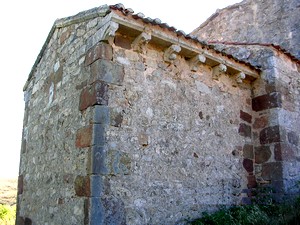 The rest that might have existed were replaced by two larger ones, one on the northern side and another one on the southern one, both ending on a semicircular arch and with primitive Romanesque decoration, obviously added later it was built since they are located in in the areas of the rebuilt walls to the extent that the one on the southern side cuts the discharge arch of the access door. Later, a rectangular window was added also within the walled-up opening on the western wall.
The rest that might have existed were replaced by two larger ones, one on the northern side and another one on the southern one, both ending on a semicircular arch and with primitive Romanesque decoration, obviously added later it was built since they are located in in the areas of the rebuilt walls to the extent that the one on the southern side cuts the discharge arch of the access door. Later, a rectangular window was added also within the walled-up opening on the western wall.
Its interior recalls the upper part of the Holy Chamber of the cathedral of Oviedo, as it also has one only nave, narrow and very high that ends in a flat chevet, much narrower and shorter, although in this case there is a small intermediate area of the same width as the nave and somewhat higher than the one in the apse. But what makes it more similar to the Asturian building is that also here a barrel vault was built later, covering the nave, supported by superimposed double transverse arches; one of them rests upon pillars against the wall and the lower one, a bit narrower, upon the bolstered 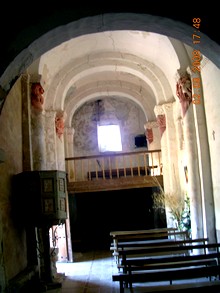 columns that rest on each pillar. The columns are formed by multiple cylindric elements generally chiseled on the same stone that forms the pillar and count with foundation, capital and abacus. The abacus protrudes from a chess like frieze that goes along the lateral walls of the nave and has a geometrical decoration in two levels, of clear Pre-Romanesque origins. However, most of the capitals, although in general they keep the Asturian wreathed collar, are already from the early Romanesque period, where the two-plane sculpture has been replaced by another one of poor quality forming generally scenes from the Bible. The decoration of the foundations is more atypical, almost all of Pre-Romanesque type with plain or wreathed collars although one shows a complex rough decoration of poor quality that goes up to the beginning of the shaft, and all of them upon odd rectangular plinths or star shaped with a simple wreathed decoration. Also the chevet is a very simple one, since whilst the semicircular arch that lets access to the chancel rests upon a line of ashlars without any decoration, at the entrance of the apse there is a double arch with a structure similar to the transverse arches of the nave, so that the interior rests upon pillars with impost and the outside upon columns with capital, also without decoration in both cases. The two spaces are covered by half barrel vaults.
columns that rest on each pillar. The columns are formed by multiple cylindric elements generally chiseled on the same stone that forms the pillar and count with foundation, capital and abacus. The abacus protrudes from a chess like frieze that goes along the lateral walls of the nave and has a geometrical decoration in two levels, of clear Pre-Romanesque origins. However, most of the capitals, although in general they keep the Asturian wreathed collar, are already from the early Romanesque period, where the two-plane sculpture has been replaced by another one of poor quality forming generally scenes from the Bible. The decoration of the foundations is more atypical, almost all of Pre-Romanesque type with plain or wreathed collars although one shows a complex rough decoration of poor quality that goes up to the beginning of the shaft, and all of them upon odd rectangular plinths or star shaped with a simple wreathed decoration. Also the chevet is a very simple one, since whilst the semicircular arch that lets access to the chancel rests upon a line of ashlars without any decoration, at the entrance of the apse there is a double arch with a structure similar to the transverse arches of the nave, so that the interior rests upon pillars with impost and the outside upon columns with capital, also without decoration in both cases. The two spaces are covered by half barrel vaults.
In principle, and in lack of a deep research of this building and its environment, everything seems to indicate that this church went through three building phases, without considering the works already mentioned during the l8th century. Let us view the characteristics we believe most meaningful to reach this conclusion.
- Both, the general structure of the building as well as the doors that have been preserved on the southern side and another one walled-in on the western wall, both linteled with a semicircular discharge arch and around three walled-in spans, and also ending in a semicircular arch placed in a way that indicates the existence of a triple portico with staircases in the two lateral compartments and a central choir higher, are of clear Asturian descent. Also the wide utilization of wreathing in the interior decoration and the crosses that decorate some corbels indicate an obvious relationship with Asturian art.
- The windows on the northern and southern sides and the decoration of the capitals and some foundation in the interior of the nave show there was a wide remodelling of the church on the initial phase of the Castilian Romanesque. Modillions also appear with primitive Romanesque decoration mingled with other previous styles.
- The existence of construction strips based on slabs and spikes and the location of the church on a very high area, something very unusual in Pre-Romanesque constructions after the 6th century, as well as the fact that there were not any horseshoe shaped arches nor vaults that may be considered to belong to the Visigothic period, leads us to consider the possibility that, as in St. Vicente del Valle, also built upon a small elevation of the ground, the origin of this church may have been Romanesque or Early-Christian in an area we know was inhabited since those times and that it would continue being utilized during the Visigothic monarchy, until it was destroyed in great part during the Arabian invasion
Conclusions
Regarding what is mentioned above we can establish the hypothesis -pending, of course, on an archaeological research in depth of all its environment- about the history of this hermitage, that  coincides greatly with the one offered by Mr. Braulio Valdivielso, according to the following phases:
coincides greatly with the one offered by Mr. Braulio Valdivielso, according to the following phases:
-
Ealy-Christian: 3rd to 5th centuries. This must have been a building quite similar to the present one because of the distribution of the remains of the construction in spikes, including its chevet where the spike is found up to medium height. On this subject, Luis Sáez Abad has sent us the following information in January 2012: “In case it might be of interest to you, a few years ago, during a procession celebrated in this village and on the way to the fore mentioned hermitage, and after the ground was turned over for the refurbishment of the road, I found a Roman coin. I am not an expert, but this makes me think that previously, as indicated on the file, it was a Roman temple. (See coins).
-
Asturian: From the end of 9th century until beginnings of the 10th. In times of Alphonse the Great the kingdom of Asturias extended its borders up to the river Duero. We know he fortified Burgos, very close o this hermitage, that had to be rebuilt in this period by people that came from the north since, as already mentioned, shows clear influences from the Asturian art. Its structure must have been identical to the present one, with flat wood cover in the nave, besides the two-storey portico that disappeared in the last century.
-
Romanesque: From the end of the 11th century until beginnings of the 12th. Keeping a great part of the church structure, two Romanesque windows open and the nave vaults, adding pillars, columns and traverse rib arches. It is possible that during this period took place the replacemnet of the original apse’s access by the present double arch, as it has the same structure of the ones built in the nave but keeping a strucure similar to the former one, reutilizing some modillions and adding other new ones.
There is no question that we are in front of a very little known church although of great interest -depending on the findings of a research in depth- not only from the artistic point of view but also from the historical one.
Other interesting information
Access: Salir de Burgos por la N-120 en dirección Logroño. A unos 10kms, antes de llegar a Ibeas de Juarros, tomar la BU-V.8002, a unos 7,5Km se encuentra Cueva de Juarros. Coordenadas GPS: 42º 16′ 56,85N 3º 32′ 8,94″W.
Teléfono de Información: Ayuntamiento de Ibeas de Juarros, 947.421.005,
Junta Vecinal de Cueva de Juarros: 947.48.66.83 Jesús
Bibliography
Historia de España de Menéndez Pidal: Tomos III, VI y VII*
Ermita de la
Virgen del Cerro: Braulio Valdivielso Ausín
L’Art Preroman Hispanique:
ZODIAQUE




